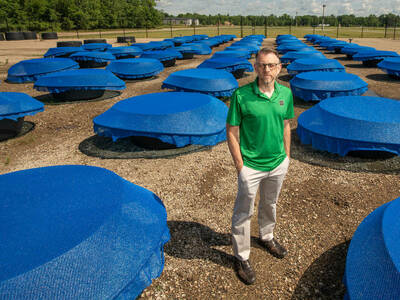
Public discourse in recent years about an “insect apocalypse”—sometimes described as the loss of 75 percent of insects during the past 50 years—might sound overblown, because research has not been comprehensive and some studies have minimized the notion altogether.
After completing research using federally funded biodiversity monitoring datasets from streams across the United States, however, University of Notre Dame biologist Jason Rohr has accepted the buzz: Insects, he concluded, are on the decline in U.S. streams.
Rohr, the Ludmilla F., Stephen J., and Robert T. Galla College Professor and Department Chair in the Department of Biological Sciences, and collaborators published their recent findings in Science Advances. Their comprehensive work showed that human activities are likely contributing to changes in insect populations in streams, and that current efforts to protect and restore them are not sufficient.
Previous studies had more limited biodiversity and spatial scope and had not taken into account complex sampling designs, land use, and improvements in the ability of scientists to identify macroinvertebrates (which include insects, snails, and worms) and insects to genus and species, Rohr said.
“If you don’t account for the fact that the scientists got better at identifying organisms down to genus levels through time, it looks like the density and number of species is increasing,” said Rohr, who is affiliated with the Environmental Change Initiative. “That’s one of many methodological artifacts that we ended up controlling for in our study, in addition to using a more comprehensive dataset than most previous studies. These factors allowed us to be more confident about our conclusion that aquatic insects are declining.”
The results of their study are multifaceted. Declines in insect populations depended on location, metrics, and several other factors. Rohr and collaborators holistically evaluated multiple facets of biodiversity in streams across the country, using 27 years of data from the United States Geological Survey (USGS) and the Environmental Protection Agency (EPA). The data helped them determine that macroinvertebrates have suffered losses in some areas but gains in others, depending on the genus and type of stream.
Researchers found that during almost three decades, the density of macroinvertebrates has decreased, while the diversity of these species has increased. But the differences in richness—the number of genera—and composition between streams that drain from forests, wetlands, and grasslands and those that drain from urban or agricultural areas has increased over time. According to the study, urban and agricultural streams lost organisms that are sensitive to disturbances, such as many insect species. These streams then gained other organisms that are more tolerant of human disturbance, like worms and snails. This caused the streams with higher disturbance to be more similar to each other over time.
“All of those sensitive taxa are disappearing and being replaced by more of the ‘weedy’ taxa,” Rohr said.
The team has not determined causation, so issues surrounding insecticide use, fertilizer, and any other type of potential disturbance are variables for another study.
While most people don’t love insects, their decline is a bellwether for the environmental health of freshwater in the United States. Although the Clean Water Act of 1972 should have improved freshwater quality and insect biodiversity in U.S. streams, increased agriculture, urbanization, and other human disturbances seem to be contributing to a continued decline over time, Rohr said.
“We need to pay attention to these heavily impacted streams, and think about mitigation measures and restoration,” he said. “Otherwise we will see continued changes in biodiversity in the direction of ‘weedy’ disturbance-tolerant species that could more adversely impact the functions that freshwater ecosystems provide to humans.”
Other researchers on the paper include Samantha Rumschlag, first author and former postdoctoral researcher in the Rohr Lab, now for the EPA in Duluth, Minnesota, as well as Michael B. Mahon and Devin Jones, also former postdoctoral researchers in the lab. Other authors include researchers from the EPA; Purdue University, West Lafayette, Indiana; the USGS; Duke University, Durham, North Carolina; the University of Namur, Namur, Belgium; University of Koblenz-Landau, Landau, Germany; Cary Institute of Ecosystem Studies, Millbrook, New York; University Angers, Angers, France; and Regis University, Denver, Colorado.
The research is supported by the John Wesley Powell Center for Analysis and Synthesis, funded by the USGS.
Originally published by at science.nd.edu on June 15, 2023.